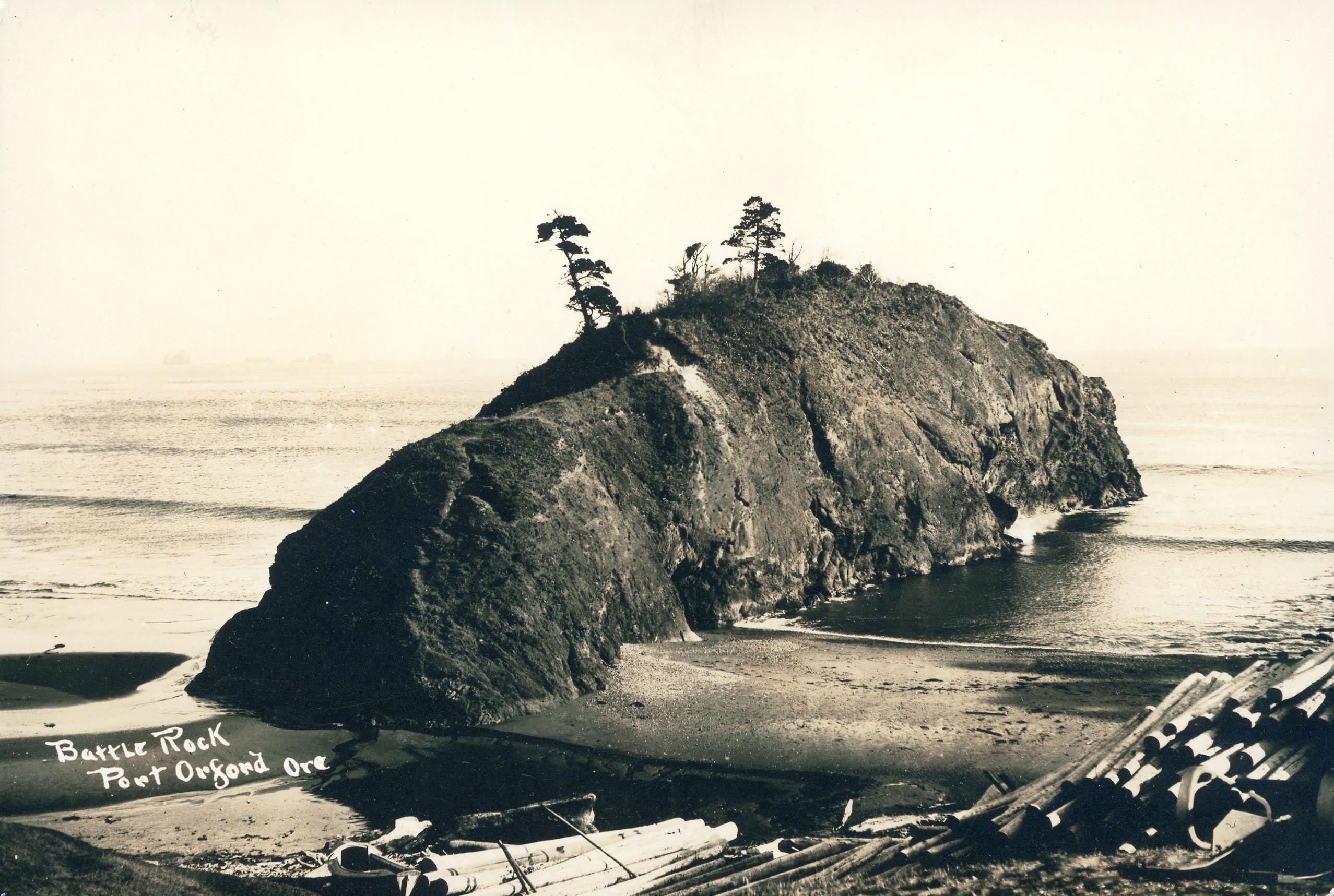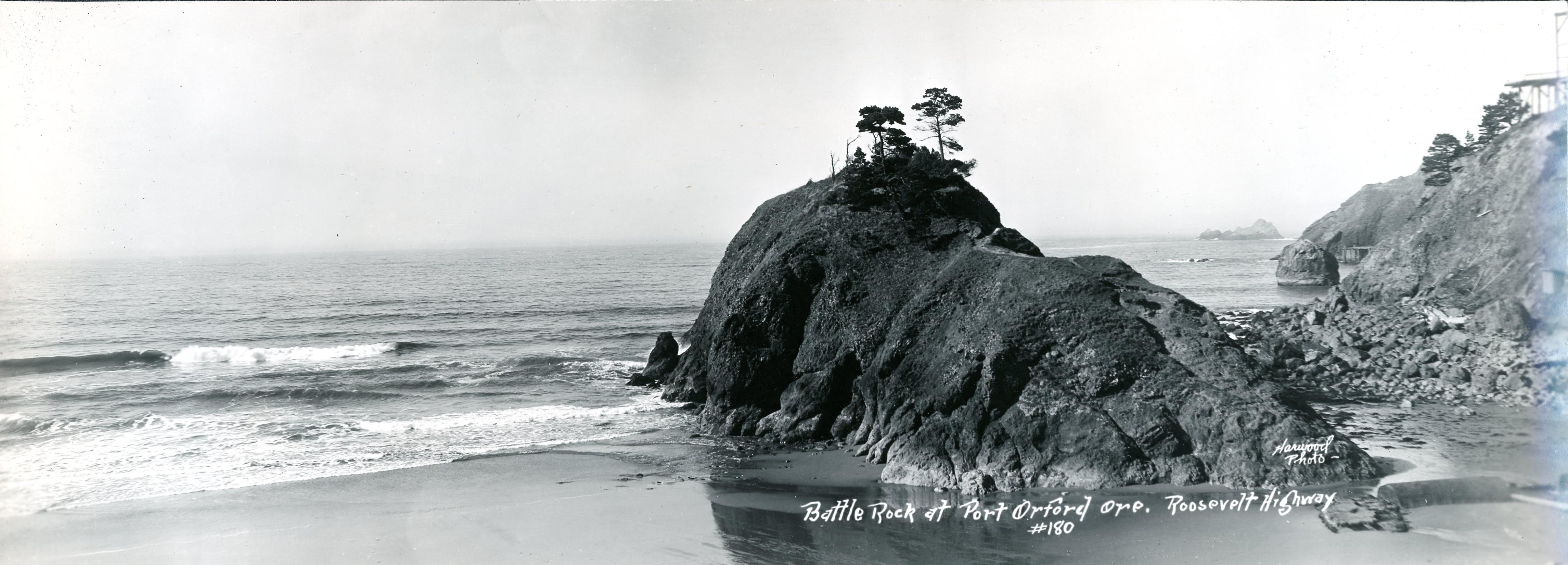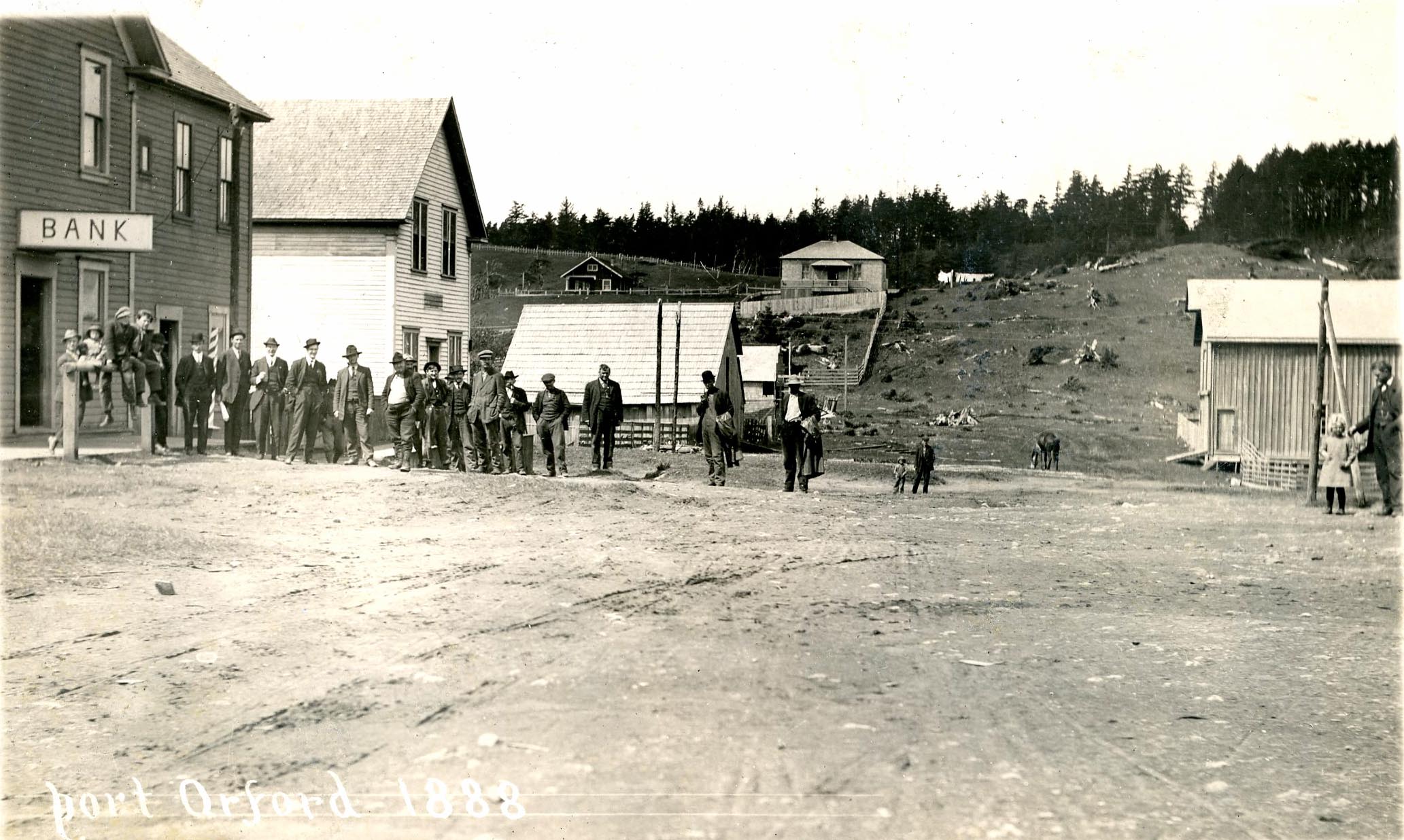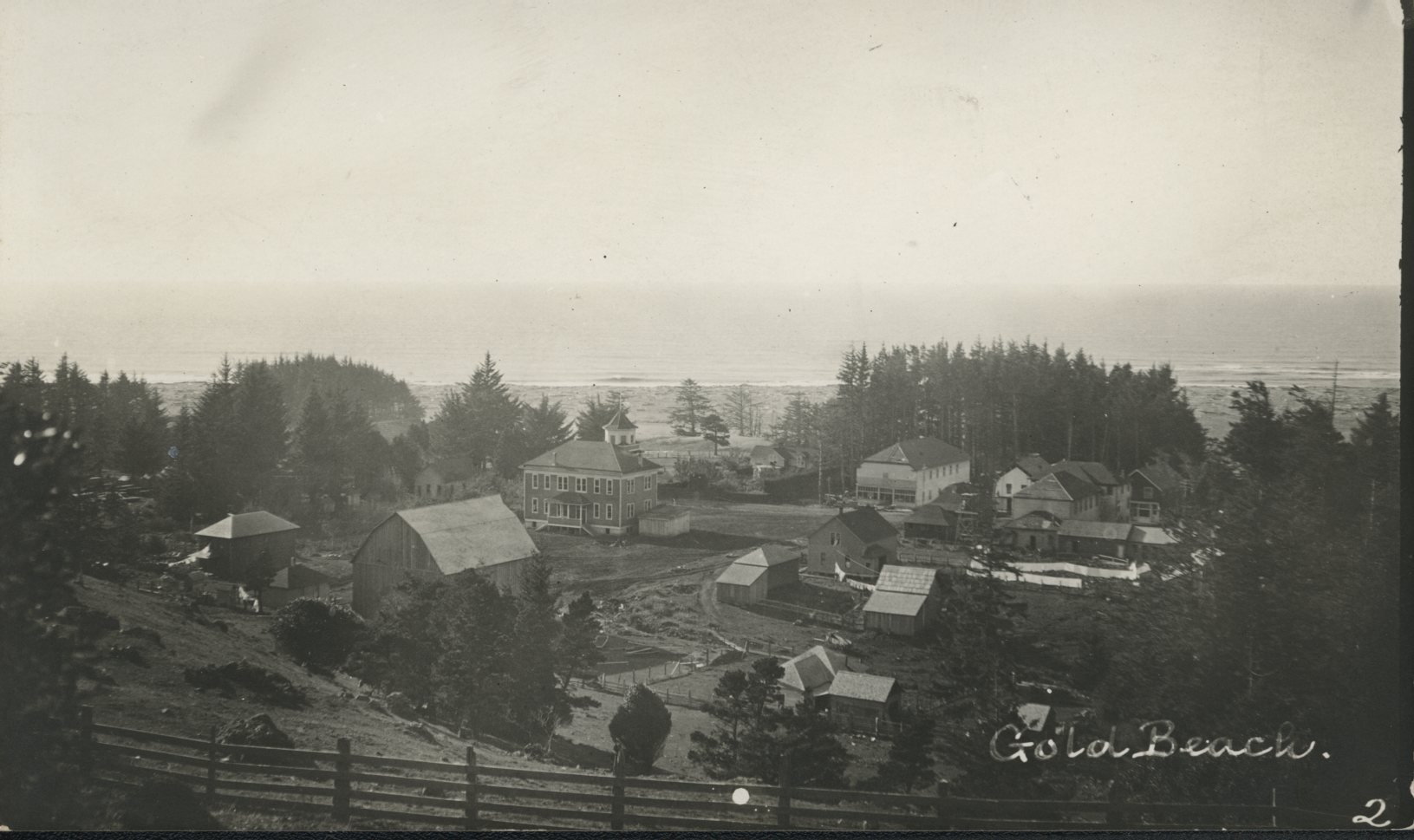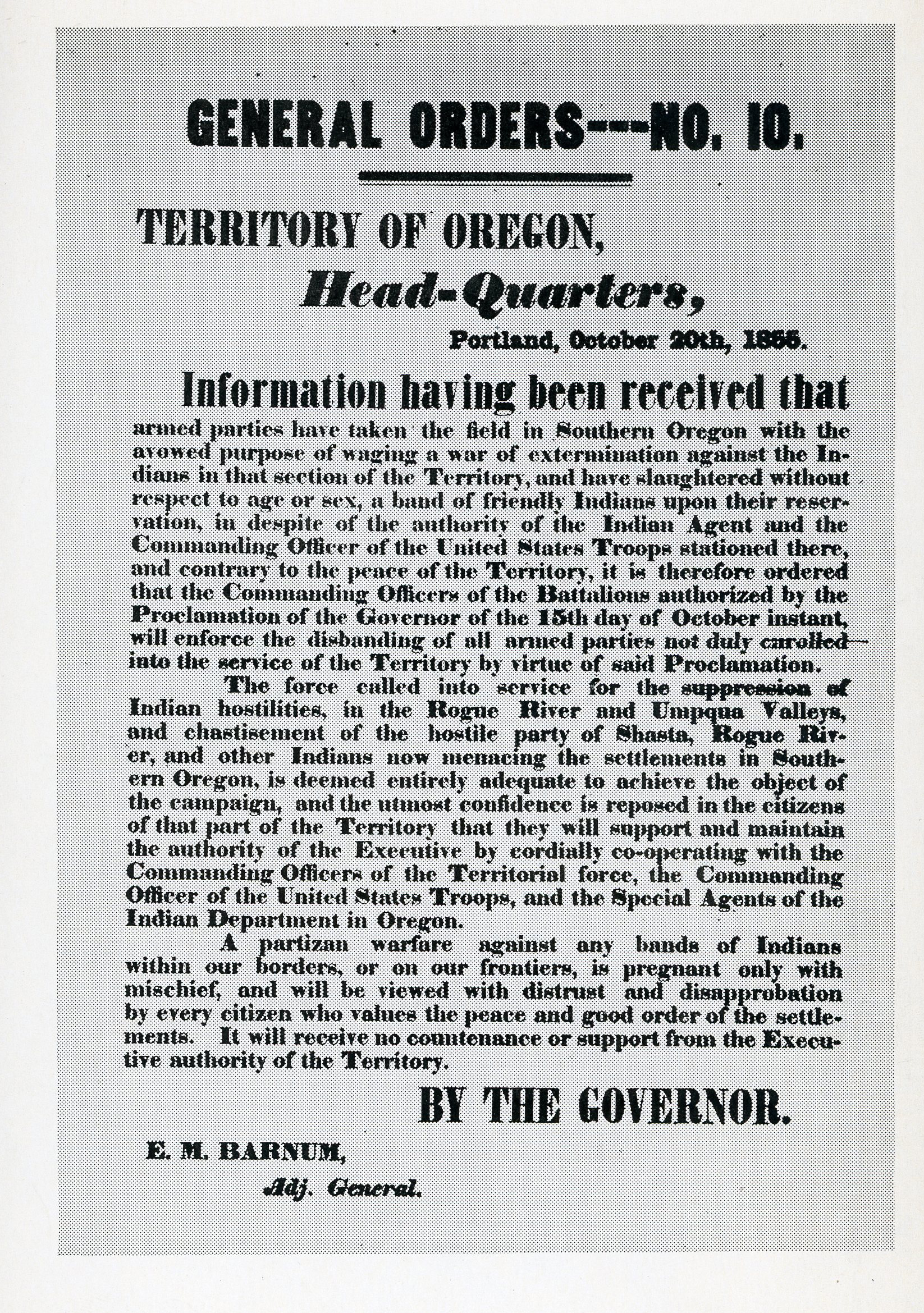On June 10, 1851, Battle Rock—a basalt promontory at Port Orford on the southern Oregon coast—was the site of a deadly confrontation between a landing party from Portland and the Quatomah, an Athapaskan people who lived in the area. Heavily propagandized by early writers, the story of Battle Rock was often framed as a heroic foundational tale of Anglo-American “civilization” in the region, with the rock itself becoming a symbol of this supremacist ideology. At least two Indigenous resisters were executed on the rock’s summit during the so-called Rogue River Wars, signifying its altarlike status. For much of the twentieth century, costumed reenactments of the battle were staged on the rock as the grand finale of Port Orford’s annual Fourth of July Jubilee.
Although Battle Rock is often written about as established history, what actually transpired is far from certain. A month following the incident, an account written by J. M. Kirkpatrick, a member of the landing party, was mailed to the editor of the Oregon Statesman. Kirkpatrick wrote that he had been working as a carpenter in Portland when he and eight others were recruited by steamship captain William Tichenor to help establish a coastal supply town. The nine men were reportedly deposited on the beach with orders to survey the area and erect a few preliminary structures. Tichenor then continued south to San Francisco, promising to return in exactly fourteen days.
The Quatomah were friendly at first, Kirkpatrick wrote, but they became upset when they realized the men were there to stay and ordered them to leave. Refusing, Kirkpatrick and his companions lugged their gear to the top of what would later be called Battle Rock, where they fortified an encampment with a cannon from Tichenor’s ship. The following morning, according to Kirkpatrick, “about forty” Quatomah attempted to force their way into the camp. In the ensuing chaos, the cannon was fired directly into their ranks, “killing some six or eight dead.” Many of the Quatomah were then either gunned down or beaten to death, resulting in a purported “twenty killed and fifteen wounded.” Kirkpatrick claimed that four members of the landing party sustained injuries, none of them life threatening.
Later in the day, the men “made signs” with the Quatomah, indicating they would leave the area after fourteen days, and from that point on they were left alone. When Tichenor did not return when he had promised, however, the Quatomah came back in greater numbers, likely augmented by at least one other Athapaskan band in the region. Kirkpatrick wrote that the leader of the Quatomah, despite his best efforts, could not persuade his followers to rush the rock a second time. Eventually, they moved off down the coast, where they lit several bonfires. Seeing an opportunity, Kirkpatrick and the others decided to “take to the woods,” and after several harrowing days made it safely to the town of Gardiner on the Umpqua River—and into local lore.
Forty-seven years later, in 1898, the seventy-year-old Kirkpatrick told a lengthier version of the story, which depicted the landing party, “with the air full of arrows,” courageously fending off “at least one hundred” Quatomah. When compared with his largely forgotten 1851 letter, it is clear that he fabricated much of this second story. The Quatomah leader who was unable to persuade his group to rush the rock a second time in the 1851 version, for example, was successful in the later telling; and Kirkpatrick, at the last moment, heroically shot him from one hundred yards, thereby halting the charging war party. Despite its questionable authenticity, the highly sensationalized retelling of the story became the primary source for what occurred and has since been cited in everything from 1960s pulp magazines to present-day academic journals.
While it is impossible to know exactly what happened on that June day in 1851, there is compelling evidence that it may have been quite different than what the “battle” narrative would have us believe. In 1886, a former member of the landing party, J. H. Egan, recalled that the Quatomah had climbed up the rock to enter the men’s camp but were stopped halfway, where he and a few others “parlayed with them.” He went on to say that “the pressure from behind was too strong, so we fell further back.” Eventually, according to Egan, the Quatomah began “snatching at our clothes, provisions and other property.” As the situation became more hectic, a member of the landing party came forward with an “armful of shirts” and threw them to the Quatomah, which caused a rush toward the camp. It was in that moment, Egan wrote, that “we met them with a discharge of our cannon.” When the event is viewed this way, it is understandable why ethnologist J. P. Harrington, after interviewing an informant on the Siletz Reservation, wrote in his notebook that the “battle” of Battle Rock “is mostly lies.”
Tichenor returned, saw that Kirkpatrick and the others had fled, and sailed to San Francisco for more men. He used his reinforcements to build a fort at Cape Orford, which was eventually taken over by the U.S. Army for use during the Rogue River Wars. Tichenor was able to build his American settlement, permanently displacing the Quatomahs from their homelands.
-
![]()
Battle Rock.
Oregon Historical Society Research Library, ba012979, photo file 877B
-
![]()
Battle Rock, 2022.
OE staff
-
![]()
Battle Rock.
Oregon Historical Society Research Library, Orhi101439, photo file 877B
-
![]()
Battle Rock.
Oregon Historical Society Research Library, ba012980, photo file 877B
-
![]()
Battle Rock.
Oregon Historical Society Research Library, photo file 877B
-
![]()
A sketched depiction of the fight on Battle Rock in Harper's Monthly, 1851.
Oregon Historical Society Research Library, Orhi9888
Related Entries
-
![Athapaskan Indians]()
Athapaskan Indians
According to Tolowa oral histories, the Athapaskan people of southern O…
-
![City of Port Orford]()
City of Port Orford
Port Orford claims to be the oldest town site on the Oregon coast, dati…
-
![Gold Beach]()
Gold Beach
The City of Gold Beach sits just south of the Rogue River, about forty …
-
![Rogue River War of 1855-1856]()
Rogue River War of 1855-1856
The final Rogue River War began early on the morning of October 8, 1855…
Related Historical Records
Map This on the Oregon History WayFinder
The Oregon History Wayfinder is an interactive map that identifies significant places, people, and events in Oregon history.
Further Reading
“Correspondence of the Statesman.” Weekly Oregon Statesman, July 15, 1851, page 2.
Dodge, Orvil. Pioneer History of Coos and Curry Counties, Oregon. Salem, Ore.: Capital Printing Co., 1898.
“Indian War Veterans.” The Morning Oregonian, February 21, 1886, page 5.
The John Peabody Harrington Papers, Alaska/Northwest Coast, MF Reel 26, Image 393, National Anthropological Archives, Smithsonian Institution.



